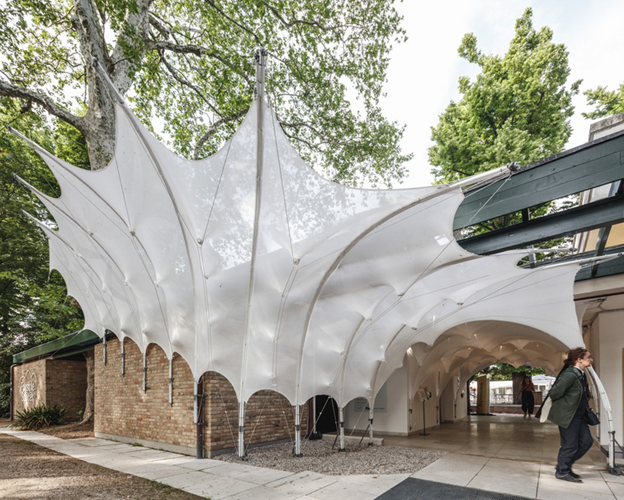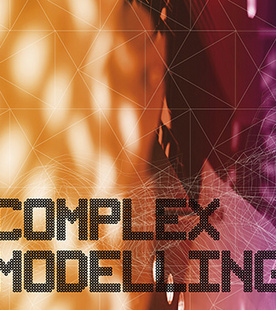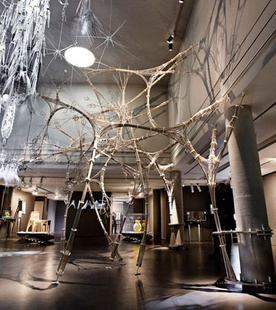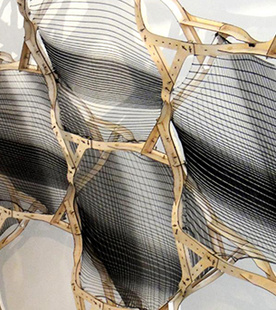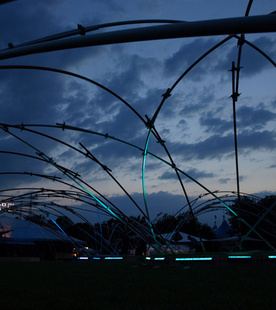Isoropia
'Isoropia' - meaning balance, equilibrium and stability - is a finely tuned balance of tension and compression. Here, bespoke knitted textiles with varying material properties embed active bent fiberglass rods and together they find their equilibrium and form.
'Isoropia' investigates how computational design allows us to rethink material use in architecture. By prototyping new integrative design methods that enable feedback between design, structural form finding, analysis and fabrication, Isoropia advocates a lighter architecture in which material behaviours - the bending, and stretching of materials - are actively employed and balanced to build smarter with less.

Collaborative Innovation
'Isoropia' is an example of collaborative innovation. It is the product of a broad interdisciplinary collaboration crossing academia and practice. Together we have explored methods for integrating light-weight simulation into architectural design tools. Traditional tools require labour intensive manual prototyping and elaborate structural calculation.
Because of this, analysis happens after design. However, if early stage design modelling systems can allow an understanding of material behaviour it can enable innovative structural and material investigations that radically challenge how architecture is built.
As such, 'Isoropia' showcases how small distributed groups are able to make big changes in former industry dominated areas. This grassroots innovation is community led and open source, creating a free-space for imagining what the material practices of architecture can be.
The community forms around the development of Kangaroo and similar software tools and includes among others members of: CITA, Department for Structural Design and Technology (KET), University of Arts Berlin, Fosters + Partners,Robert McNeel & Associates,Technical University of Denmark,Format Engineers andMule Studio.

Designing with interactive behaviours
Specifically, 'Isoropia' examines how to design with interacting behaviours. Structures are rarely mono-material or purely in tension or compression. Instead they are composed of multiple materials that each hold their own performance. In 'Isoropia' the tensile forces of the bending active fiberglass are counterbalanced by the knitted textile system. A stable equilibrium is established, which avoids counterweights as in traditional membrane architecture. The developed design method allows us to understand the interaction between the material systems and design their relationship. By minimising the textile, thickening the fibreglass rod or tensioning the textile protrusions, the structure changes in expression and form.
'Isoropia' uses knit as a textile membrane. Knit is softer and less homogenous than traditional laminated membranes and can therefore be used at very different scales. 'Isoropia' is knitted in Dyneema, a high performance polyester with practically no stretch. The material performance of the knit - its ability to stretch and deform is therefore uniquely down to the structure of the knit. In 'Isoropia' we vary the knit structures to compose areas of more or less stretch. By building our own interfaces between the computational design environment and the digital knitting machine we are able to control fabrication at stitch by stitch level. The textile are bespoke produced as one-off custom patches and detailing such as the channels, the protrusions and perforations are controlled directly from the design environment.
Realisation
The realisation of 'Isoropia' builds on an interdisciplinary collaboration between CITA, Centre for IT and Architecture (design and computation),str.ucture (engineering), AFF - A. Ferreira & Filhos, SA (knit fabrication),DSM Dyneema B.V (fibre) and alurays lighting technology GmbH (lighting). The project is kindly sponsored byToppglass Italy (GFRP tubes),Sofistik (FE analysis) and SIKA (Glue).
The second collaboration is the interdisciplinary partnership that have realised the structure in a close development process between architects from CITA, engineers from str.ucture, light designers from Alurays and textile experts from AFF - A. Ferreira & Filhos, SA and Dyneema B.V.
Isoropia Installation
Partners
- CITA / Denmark -www.kadk.dk/cita
- AFF - A. Ferreira & Filhos, SA / Portugal – www.aferfi.com
- Str.ucture / Germany - www.str-ucture.com
- DSM Dyneema B.V / The Netherlands www.dsm.com
- Alurays / Germany -http://alurays.de/
- Sponsors
- Toppglass / Italy http://topglass.it/
- Sofistik / Germanyhttps://www.sofistik.de/
- SIKA / Germany https://www.sika.com/
Support
- Danish Ministry of Higher Education and Science - Complex Modelling - Sapere Aude: DFF-Starting Grant /https://ufm.dk/
- Collaborative Innovation – Community
- CITA / Denmark - http://www.kadk.dk/cita
- Kangaroo / Daniel Piker - http://www.food4rhino.com/app/kangaroo-physics
- Department for Structural Design and Technology (KET), University of Arts Berlin / Germany https://www.udk-berlin.de/studium/architektur/fachgebiete-der-architektur/konstruktives-entwerfen-und-tragwerksplanung/
- Fosters + Partners -https://www.fosterandpartners.com/
- Robert McNeel & Associates -https://www.mcneel.com/eu/
- Technical University of Denmark (DTU) - www.dtu.dk
- Format Engineers / United Kingdom - http://formatengineers.com/
- Mule Studio / United Kingdom -http://www.mule.studio/
